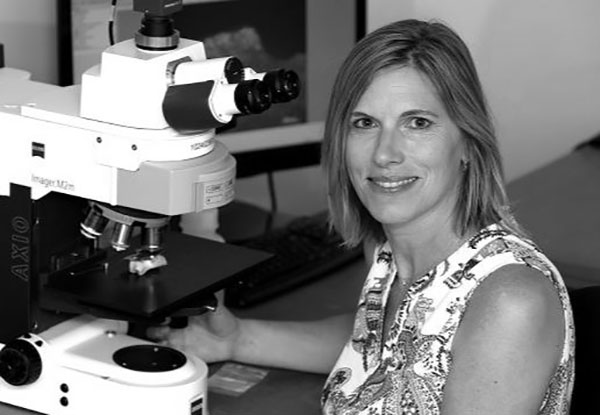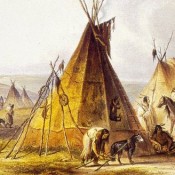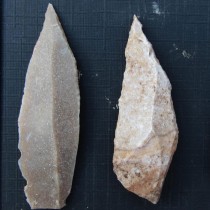The 2022 Francqui Prize in Human Science is awarded to Veerle Rots, Senior Research Fellow of the F.R.S.-FNRS at the University of Liège, for her pioneering research on prehistoric stone tools and the evolution of human behaviour. Veerle Rots is the first woman of the University of Liège to be awarded this prestigious prize.
For more than 10 years, Veerle Rots, archaeologist at the University of Liège, has been trying to decipher the behaviour and evolution of Neanderthals and early modern humans through the analysis of the traces left on the stone tools. This research opens the door to the understanding of the mysterious world of 250,000 years ago and shows that Neanderthals were much more innovative than previously thought. Moreover, they may not have differed so much from early modern humans. With TraceoLab, the laboratory she set up at the University of Liège, Veerle Rots has developed the largest reference collection in the world and she has also set up a robust analytical framework. This detailed analytical framework is internationally recognised and is used by many young scientists.
Microscopic analyses that provide a better understanding of human life in prehistory
The mounting of stone tools on an organic handle has been one of the elements that help to better understand the technological innovations and cognitive development of humans during the Old Stone Age (Palaeolithic). However, it has proven difficult to study the appearance and evolution of hafting, as organic material only rarely preserves.
Professor Veerle Rots, Senior Research Fellow of the F.R.S.-FNRS (the Belgian National Fund for Scientific Research) at the University of Liège, took up the challenge. During her PhD research at KU Leuven, she developed a methodology to permit the identification of hafting based on microscopic wear traces. In the prolongation of this successful work, Veerle Rots and her research team set up TraceoLab at the University of Liège, a fully equipped research laboratory. With this brand-new research centre, Prof. Rots focused specifically on refining her methodology, integrating it into a solid research framework and applying it to numerous archaeological sites in Europe and Africa. This has enabled the study of Neanderthal and early modern human sites and comparisons of their material culture and way of life.
“Through microscopic analysis of stone tools, we have studied the invisible traces of human life in prehistory. The wear traces on the stones allow us to identify which technology was used and what materials were processed, even if no organic material remains. For example, in my research I focused on finding a way to determine without the organic material what hunting technique was used, which would permit is to identify from when long-distance weaponry was used, such as the spear-thrower and the bow. The hunting technique used also provides insights into the social organisation of human groups in the Palaeolithic. Thanks to this type of microscopic analysis, we can not only discover information about prehistoric technologies and subsistence strategies, but also about the function of a site, the organisation of activities and the complexity of human behaviour. It informs us that Neanderthals were more strategic than previously thought and that they were already capable of making complex tools. In fact, the concept of hafting is much older than we thought and dates back to at least 250,000 years ago. This discovery is revolutionary,” explains Veerle Rots.
A fully equipped research centre with the largest reference collection in the world
Professor Veerle Rots has made considerable efforts to raise the necessary funds, including funding from the European Research Council (ERC Starting Grant), to set up a new, fully equipped laboratory. This result is TraceoLab, a highly efficient research centre where Veerle Rots and her team carry out all experiments and analyses that are crucial to make progress in their field of research.
The analytical framework that was gradually developed at TraceoLab under direction of Veerle Rots is truly robust because it takes into account (1) all possible processes (production, resharpening, use, hafting, etc.) that lead to wear and residue formation, (2) technology, (3) specific knowledge regarding raw material properties , (4) trace formation processes (fracture mechanics, wear, etc.) and the influence of the depositional context (friction, adhesion, transformation, etc.), (5) experiments and (6) rigorous analytical practices.
TraceoLab has also developed a reference collection named TRAIL (“Traces In Liège”). This collection of no less than 6,000 pieces allows for a better understanding and analysis of archaeological wear traces and residues, but also of stone tools, technologies, site function and human behaviour in the past. Professor Rots has as such created the world’s largest reference collection for functional research.
A passion she has nurtured since childhood
Veerle Rots has been reading books on prehistory from an early age, a fascination that has clearly paid off.
“I soon realised that I had to study archaeology. When I had the chance to go to Egypt for fieldwork during my Master thesis on the study of use-wear traces , I was totally convinced! Before I knew it, I got a scholarship to do a PhD on this research topic. During my postdoctoral research, I was then able to put the theory into practice. The real icing on the cake was, of course, when I got a permanent position at the University of Liège and was able to set up a research centre. Together with my team, I work there on research directions that we have developed ourselves.”





